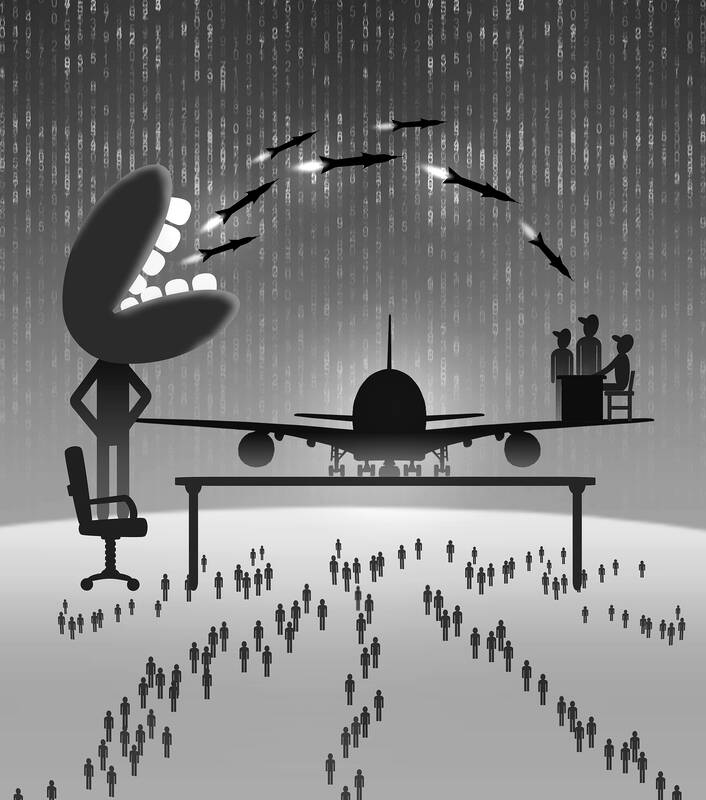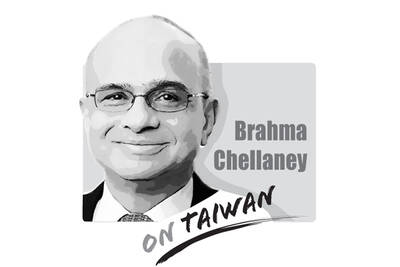Members of the US Senate Permanent Subcommittee on Investigations underscored at a hearing on Wednesday last week that they did not want to stoke panic about planes made by Boeing Co, then almost uniformly expressed urgent concern about the public’s safety aboard the company’s jets.
“There are real people at risk getting on airlines right now,” said Senator Richard Blumenthal of Connecticut, the panel’s chairman.
Senator Ron Johnson of Wisconsin probably summed up the day’s attitude best: “What I don’t want this committee to do is to scare the you-know-what out of the American public. In the end, I want the public to be confident in getting on an airplane and experiencing air travel. But I have to admit this testimony is more than troubling.”

Illustration: Yusha
The testimony he was referring to came from a purported whistle-blower about flaws in the planemaker’s assembly process for the 787 Dreamliner and three others, including Foundation for Aviation Safety executive director Ed Pierson, who said: “Unless action is taken and leaders are held accountable, every person stepping aboard a Boeing airplane is at risk.” So much for not scaring the flying public.
The problem is that Boeing, the subject of two Senate committee hearings about its safety record on the same day, does not need a growing chorus of naysayers to solve its well-detailed problems, whether or not they have been self-inflicted. For his part, Blumenthal said he was not done; he said he expected Boeing chief executive officer David Calhoun to appear before the panel at some point.
However, Boeing, is not just any company that can be replaced easily or that could fade away without anyone being impacted. It is a flagship US aircraft manufacturer that has already ceded its global leadership position to Airbus SE. Boeing needs to correct its course and return to its origins of making great planes — not to be dragged down by a narrative that all of its aircraft are unsafe.
Right now, Boeing is losing that narrative. Of course, it put itself into this position with two fatal crashes of the 737 Max aircraft within five months in 2018 and 2019 and then the outrageous blowout of a fuselage panel on a 737 during an Alaska Air Group Inc flight at the beginning of the year.
Now anything that goes wrong during a flight on a Boeing plane makes headlines without the distinction that airlines are in charge of maintenance once the aircraft is delivered. When a tire fell off a United Airlines Holding Inc flight in midair or when a United aircraft veered off the runway in Houston, the incidents were chalked up as another mishap involving a Boeing aircraft. The same media frenzy happened when an engine cover blew off during take-off of a Southwest Airlines Co flight. The plane was an older model of the Boeing 737 and the fault points clearly to Southwest maintenance crews that did not batten down the cowling.
To give an idea of how the company has lost the narrative, people have twisted the old saying “If it ain’t Boeing, I ain’t going” into “If it’s Boeing, I ain’t going.”
Again, Boeing brought this on itself.
However, it does not help for the Senate to pile on while the company is struggling. Lawmakers are giving the spotlight to a whistle-blower who is making claims that are just as hard to refute as they are difficult to corroborate.
Sam Salehpour, a longtime Boeing employee, last week made public his concerns that the assembly process on the widebody 787 aircraft could cause accelerated fatigue on the fuselage of more than 1,000 aircraft. The 787 Dreamliner is the company’s first plane to use carbon fiber composite materials for the fuselage and wings, making it Boeing’s most innovative and efficient aircraft, the company said.
Salehpour, an engineer who worked on the 787 from 2020 through early 2022, said Boeing was “in a mad rush” to assemble the planes to reduce backlog and failed to follow its engineering requirements.
Boeing disputes this, and says it stands by the structural integrity of the 787. The 787 has already been highly scrutinized dating back to 2020 when the plane was grounded after a series of flaws cropped up. Boeing found imperfections in how the fuselage barrels at the end of the plane were joined together and another on improper gaps on the stabilizer, which is a small wing at the tail of the aircraft. The US Federal Aviation Administration (FAA) got involved early on in this process as Boeing combed the plane for more flaws. Customers, who wanted the plane, grew impatient.
The FAA finally gave Boeing the nod to resume deliveries of the 787 in March last year after many starts and stops because of small imperfections that kept popping up.
Boeing recommended on Monday last week that the plane’s operators inspect the aluminum forward pressure bulkhead that helps maintain cabin pressure. The issue was discovered during Boeing’s extra scrutiny of the 787 and has nothing to do with the safety issues raised by Salehpour, the company said.
Unfortunately, it only adds to the negative narrative.
Salehpour, who is being represented by Katz Banks Kumin LLP, said he raised concerns about the 787 but was ignored by management and then, when he insisted, was threatened. He was moved to Boeing’s 777 aircraft assembly where Salehpour says he also saw improper procedures.
“Despite what Boeing officials state publicly, there is no safety culture at Boeing and employees like me who speak up about defects with its production activities and lack of quality control are ignored, marginalized, threatened, sidelined and worse,” he said in written testimony on Wednesday last week.
Salehpour’s concerns should be investigated. No one wants an unsafe plane plying the skies. The issues raised by the whistle-blower are highly technical and would be better addressed without a glaring spotlight. Perhaps a closed-door hearing to speak with Salehpour and Boeing executives under oath would have been more appropriate.
The grandstanding during public hearings that lawmakers cannot resist would not help get to the bottom of the whistle-blower’s claims. It would only stoke the fear they say they want to prevent.
Thomas Black is a Bloomberg Opinion columnist writing about the industrial and transportation sectors. He was previously a Bloomberg News reporter covering logistics, manufacturing and private aviation. This column does not necessarily reflect the opinion of the editorial board or Bloomberg LP and its owners.

Donald Trump’s return to the White House has offered Taiwan a paradoxical mix of reassurance and risk. Trump’s visceral hostility toward China could reinforce deterrence in the Taiwan Strait. Yet his disdain for alliances and penchant for transactional bargaining threaten to erode what Taiwan needs most: a reliable US commitment. Taiwan’s security depends less on US power than on US reliability, but Trump is undermining the latter. Deterrence without credibility is a hollow shield. Trump’s China policy in his second term has oscillated wildly between confrontation and conciliation. One day, he threatens Beijing with “massive” tariffs and calls China America’s “greatest geopolitical
Chinese Nationalist Party (KMT) Chairwoman Cheng Li-wun (鄭麗文) made the astonishing assertion during an interview with Germany’s Deutsche Welle, published on Friday last week, that Russian President Vladimir Putin is not a dictator. She also essentially absolved Putin of blame for initiating the war in Ukraine. Commentators have since listed the reasons that Cheng’s assertion was not only absurd, but bordered on dangerous. Her claim is certainly absurd to the extent that there is no need to discuss the substance of it: It would be far more useful to assess what drove her to make the point and stick so
The central bank has launched a redesign of the New Taiwan dollar banknotes, prompting questions from Chinese Nationalist Party (KMT) legislators — “Are we not promoting digital payments? Why spend NT$5 billion on a redesign?” Many assume that cash will disappear in the digital age, but they forget that it represents the ultimate trust in the system. Banknotes do not become obsolete, they do not crash, they cannot be frozen and they leave no record of transactions. They remain the cleanest means of exchange in a free society. In a fully digitized world, every purchase, donation and action leaves behind data.
A large majority of Taiwanese favor strengthening national defense and oppose unification with China, according to the results of a survey by the Mainland Affairs Council (MAC). In the poll, 81.8 percent of respondents disagreed with Beijing’s claim that “there is only one China and Taiwan is part of China,” MAC Deputy Minister Liang Wen-chieh (梁文傑) told a news conference on Thursday last week, adding that about 75 percent supported the creation of a “T-Dome” air defense system. President William Lai (賴清德) referred to such a system in his Double Ten National Day address, saying it would integrate air defenses into a